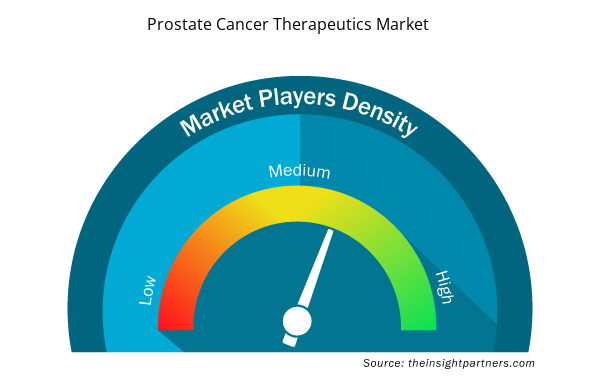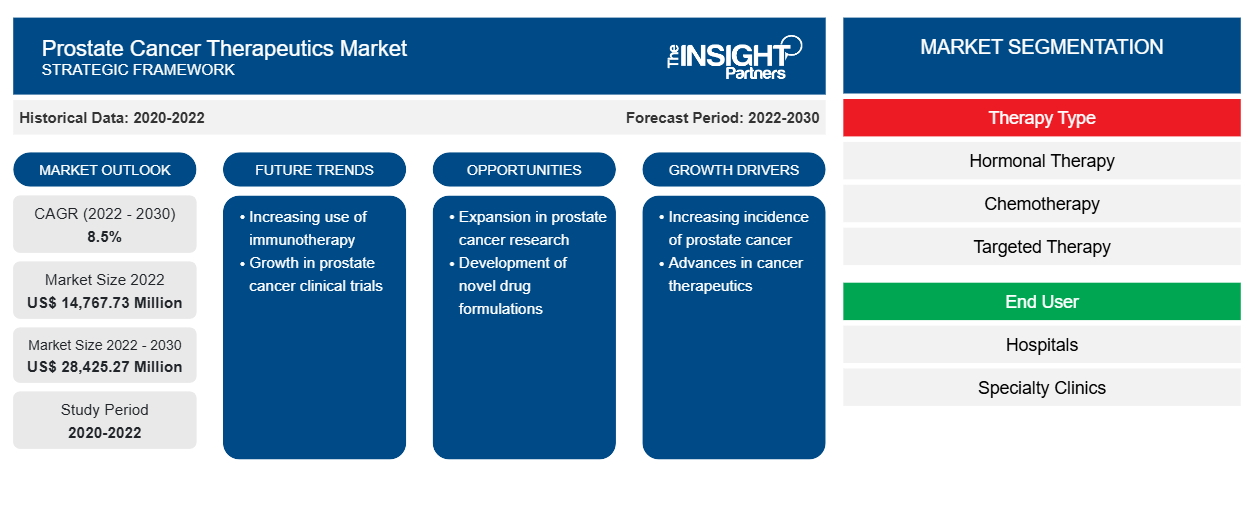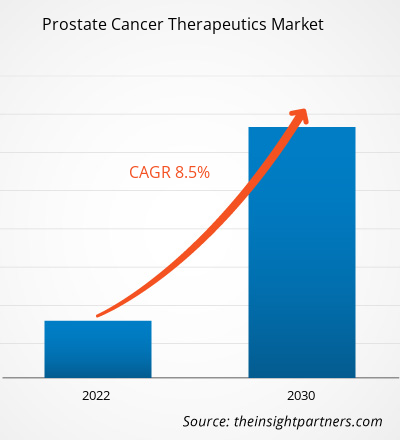[연구보고서] 전립선암 치료제 시장은 2022년 14,767.73백만 달러에서 2030년 28,425.27백만 달러로 성장할 것으로 예상되며, 2022년에서 2030년 사이에 연평균 성장률 8.5%를 기록할 것으로 예상됩니다.
시장 통찰력 및 분석가 관점:
전립선 암 치료제 시장 규모는 새로운 약물 화합물을 도입하기 위한 R&D 활동 증가, 전립선암 사례 증가, 전립선암 진단에 대한 정부 지원 증가로 확대되고 있습니다. 또한, 시장 참여자의 첨단 제품 가용성이 시장 성장을 촉진합니다. 2023년 1월, BDR Pharmaceutical은 인도에서 전립선암 치료에 사용되는 Apalutamide의 제네릭 버전을 출시했습니다. 이 약물은 APATIDE라는 브랜드로 출시되었으며 비전이성 거세 저항성 전립선암과 전이성 거세 민감성 전립선암을 치료하는 데 처방됩니다.
성장 동인 및 과제:
전립선암은 남성, 특히 50세 이상의 노인에게 가장 흔한 건강 문제 중 하나입니다. 전립선암은 대부분 비만이고 전립선암 가족력이 있는 남성에게 흔합니다. 전립선암은 종종 눈에 띄는 증상 없이 진행되므로 조용한 위협입니다. 따라서 이 암을 조기에 발견하는 것은 쉽지 않습니다. 대부분의 전립선암은 전립선 주변부에서 발생합니다. 증상이 나타나려면 암이 요도를 압박할 정도로 커야 하며, 전이로 인한 뼈 통증이 일부 경우 진행된 전립선암의 초기 증상일 수 있습니다. 그러나 하부 요로 증상, 발기 부전 또는 혈뇨가 나타나는 50세 이상의 개인은 전립선암 가능성을 고려해야 합니다. 전립선암은 전 세계 남성의 암 사망 원인 중 5위이며 두 번째로 흔히 진단되는 암입니다. 2000년 이후 전립선암 발병률이 감소했지만, 2010년부터 후기 전립선암 발병률이 증가하고 있습니다. 전립선암 발병률과 사망률은 크게 다릅니다. 선진국은 일반적으로 전립선암 발병률이 높지만 사망률은 낮습니다. 미국에서 전립선암 위험은 전 세계 위험보다 거의 4배 더 높습니다. Novartis AG에 따르면, 2020년 전 세계적으로 약 140만 건의 새로운 전립선암 사례와 약 375,000건의 전립선암 사망자가 보고되었습니다. 전 세계적으로 전립선암 사례가 증가하고 전립선암의 낮은 검출률이 전립선암 치료제 시장 성장을 촉진합니다.
귀하의 요구 사항에 맞게 이 보고서를 사용자 정의하세요
이 보고서의 일부 또는 국가 수준 분석, Excel 데이터 팩을 포함하여 모든 보고서에 대한 사용자 정의를 무료로 받을 수 있으며 신생 기업 및 대학을 위한 훌륭한 혜택과 할인 혜택을 이용할 수 있습니다.
- 이 보고서의 주요 시장 동향을 알아보세요.이 무료 샘플에는 시장 동향부터 추정 및 예측까지 다양한 데이터 분석이 포함됩니다.
보고서 세분화 및 범위:
전립선암 치료제 시장은 치료 유형, 최종 사용자 및 지역에 따라 세분화됩니다. 치료 유형별 전립선암 치료제 시장은 호르몬 요법, 화학 요법, 면역 요법, 표적 요법 등으로 세분화됩니다. 최종 사용자별 전립선암 치료제 시장은 병원, 전문 클리닉 등으로 세분화됩니다. 지리적 위치에 따라 전립선암 치료제 시장은 북미(미국, 캐나다, 멕시코), 유럽(영국, 독일, 프랑스, 이탈리아, 스페인 및 기타 유럽), 아시아 태평양(중국, 일본, 인도, 한국, 호주 및 기타 아시아 태평양), 중동 및 아프리카(UAE, 사우디 아라비아, 남아프리카 및 기타 중동 및 아프리카), 남중부 아메리카(브라질, 아르헨티나 및 기타 남중부 아메리카)로 세분화됩니다.
세그먼트 분석:
전립선암 치료제 시장은 치료 유형별로 호르몬 요법, 화학 요법, 면역 요법, 표적 요법 등으로 세분화됩니다. 2022년에 호르몬 요법 부문은 화학 요법에 이어 가장 큰 시장 점유율을 차지했으며, 같은 부문이 2022년부터 2030년까지 가장 높은 CAGR을 기록할 것으로 예상됩니다. 화학 요법은 전립선암의 중요한 치료법으로 간주됩니다. 이 요법에서 약물은 폐의 새롭거나 기존의 암세포를 파괴합니다. 전이성 전립선암에 대한 화학 요법은 증상을 완화할 수 있습니다. 또한 암을 줄이고 삶의 질을 개선하는 데 도움이 될 수 있습니다. 도세탁셀(Taxotere)은 호르몬 요법에 저항하는 환자의 전립선암 화학 요법에서 표준 치료로 간주됩니다. FDA는 또한 거세 저항성 전립선암 치료를 위해 화학 요법 약물 카바지탁셀(Jevtana)을 승인했습니다. 또한 도세탁셀을 복용하는 동안 성장한 전이성 전립선암의 영향을 받는 환자에게 사용됩니다.
지역 분석:
전립선암 치료제 시장은 북미, 유럽, 아시아 태평양, 중동 및 아프리카, 남미 및 중미로 지리적으로 구분됩니다. 북미는 글로벌 전립선암 치료제 시장 성장에 가장 큰 기여를 합니다. 아시아 태평양은 2022년부터 2030년까지 전립선암 치료제 시장에서 가장 높은 CAGR을 기록할 것으로 예상됩니다. 미국의 전립선암 치료제 시장 성장은 주로 전립선암 발병률 증가, 제품 출시 및 정부 이니셔티브에 의해 주도됩니다. 2023년 6월, AstraZeneca와 MSD의 Lynparza(olaparib)는 프레드니손 또는 프레드니솔론과 아비라테론을 병용하여 유해한 BRCA 돌연변이(BRCAm) 전이성 거세 저항성 전립선암(mCRPC)이 의심되는 성인 환자를 치료하는 데 미국에서 승인되었습니다. 또한 2023년 11월, FDA는 Astellas Pharma US, Inc.에서 제조한 제품인 엔잘루타미드를 승인했습니다. 이 제품은 생화학적 재발과 전이 위험이 높은(고위험 BCR) 비전이성 거세 민감성 전립선암(nmCSPC)의 치료에 사용됩니다.
전립선암 치료제 시장 지역 통찰력
Insight Partners의 분석가들은 예측 기간 동안 전립선암 치료제 시장에 영향을 미치는 지역적 추세와 요인을 철저히 설명했습니다. 이 섹션에서는 북미, 유럽, 아시아 태평양, 중동 및 아프리카, 남미 및 중미의 전립선암 치료제 시장 세그먼트와 지리에 대해서도 설명합니다.

- 전립선암 치료제 시장에 대한 지역별 데이터 얻기
전립선암 치료제 시장 보고서 범위
| 보고서 속성 | 세부 |
|---|---|
| 2022년 시장 규모 | 14,767.73백만 달러 |
| 2030년까지 시장 규모 | 28,425.27백만 달러 |
| 글로벌 CAGR (2022-2030) | 8.5% |
| 역사적 데이터 | 2020-2022 |
| 예측 기간 | 2022-2030 |
| 다루는 세그먼트 | 치료 유형별
|
| 포함된 지역 및 국가 | 북아메리카
|
| 시장 선도 기업 및 주요 회사 프로필 |
|
시장 참여자 밀도: 비즈니스 역학에 미치는 영향 이해
전립선암 치료제 시장은 소비자 선호도의 변화, 기술 발전, 제품의 이점에 대한 인식 증가와 같은 요인으로 인해 최종 사용자 수요가 증가함에 따라 빠르게 성장하고 있습니다. 수요가 증가함에 따라 기업은 제품을 확장하고, 소비자의 요구를 충족하기 위해 혁신하고, 새로운 트렌드를 활용하여 시장 성장을 더욱 촉진하고 있습니다.
시장 참여자 밀도는 특정 시장이나 산업 내에서 운영되는 회사나 기업의 분포를 말합니다. 주어진 시장 공간에 얼마나 많은 경쟁자(시장 참여자)가 존재하는지 그 규모나 전체 시장 가치에 비해 나타냅니다.
전립선암 치료제 시장에서 활동하는 주요 기업은 다음과 같습니다.
- 아스텔라파마 주식회사
- 존슨앤존슨서비스 주식회사
- 엘리 릴리 앤 컴퍼니
- 바이엘 AG
- 사노피
면책 조항 : 위에 나열된 회사는 어떤 특별한 순서에 따라 순위가 매겨지지 않았습니다.

- 전립선암 치료제 시장의 주요 주요 업체 개요를 알아보세요
산업 발전 및 미래 기회:
전립선암 치료 시장에서 활동하는 주요 업체의 다양한 이니셔티브는 아래와 같습니다.
- 2022년 3월, 미국 FDA는 노바티스의 플루빅토(루테튬 Lu 177 비피보타이드 테트라크세탄)를 전립선 특이 막 항원 양성 전이성 거세 저항성 전립선암(PSMA 양성 mCRPC)이라 불리는 진행성 전립선암을 앓는 성인 환자를 치료하기 위해 승인했습니다.
- 2023년 4월, FDA는 Lantheus Holdings Inc와 POINT Biopharma Global Inc에 전이성 거세 저항성 전립선암(mCRPC) 치료를 위한 177Lu-PNT2002에 대한 패스트트랙 지정을 부여했습니다. PNT2002는 PSMA 표적 리간드, PSMA-I&T, 베타 방출 방사성 동위원소 무담체 첨가 177Lu를 결합한 혁신적인 PSMA 표적 177Lu 기반 방사성 약리학적 요법으로, mCRPC를 치료합니다.
경쟁 환경 및 주요 회사:
Astella Pharma Inc, Johnson & Johnson Services Inc, Eli Lilly and Company, Bayer AG, Sanofi, Merck KGaA, AstraZeneca, Novartis AG, AbbVie, Bristol Myers Squibb는 전립선암 치료제 시장에서 활동하는 주요 기업 중 일부입니다. 이러한 시장 기업은 전 세계적으로 증가하는 소비자 수요를 충족하고 특수 포트폴리오에서 제품 범위를 늘리기 위해 신제품 출시와 지역 확장에 집중합니다. 글로벌 입지를 통해 광범위한 고객 기반을 제공할 수 있어 시장 확장이 용이해집니다.
- 역사적 분석(2년), 기준 연도, CAGR을 포함한 예측(7년)
- PEST 및 SWOT 분석
- 시장 규모 가치/양 - 글로벌, 지역, 국가
- 산업 및 경쟁 환경
- Excel 데이터 세트


- Real-Time Location Systems Market
- Public Key Infrastructure Market
- Emergency Department Information System (EDIS) Market
- Automotive Fabric Market
- Medical Second Opinion Market
- Print Management Software Market
- Molecular Diagnostics Market
- Analog-to-Digital Converter Market
- Nuclear Decommissioning Services Market
- Digital Language Learning Market

Report Coverage
Revenue forecast, Company Analysis, Industry landscape, Growth factors, and Trends

Segment Covered
This text is related
to segments covered.

Regional Scope
North America, Europe, Asia Pacific, Middle East & Africa, South & Central America

Country Scope
This text is related
to country scope.
자주 묻는 질문
Based on geography, the prostate cancer therapeutics market is segmented into North America (the US, Canada, and Mexico), Europe (the UK, Germany, France, Italy, Spain, and the Rest of Europe), Asia Pacific (China, Japan, India, South Korea, Australia, and the Rest of Asia Pacific), the Middle East & Africa (the UAE, Saudi Arabia, South Africa, and Rest of the Middle East & Africa), and South & Central America (Brazil, Argentina, and the Rest of South & Central America). North America is the largest contributor to global prostate cancer therapeutics market growth. Asia Pacific is expected to register the highest CAGR in the prostate cancer therapeutics market from 2022 to 2030.
The prostate cancer therapeutics market, by therapy type, is segmented into hormone therapy, chemotherapy, immunotherapy, targeted therapy, and others. In 2022, the chemotherapy segment held the largest market share, and the same segment is expected to record the highest CAGR from 2022 to 2030.
The prostate cancer therapeutics market, by end-user, is segmented into hospitals, specialty clinics, and others. In 2022, the hospital segment held the largest market share; moreover, the same segment is expected to record the highest CAGR during 2022–2030.
The increasing cases of prostate cancer and strategic initiatives in prostate cancer therapeutics freezer bolster the prostate cancer therapeutics market size. However, the high cost associated with prostate cancer therapeutics hinders the growth of prostate cancer therapeutics market growth.
The prostate cancer therapeutics market majorly consists of players such Astella Pharma Inc, Johnson & Johnson Services Inc, Eli Lilly and Company, Bayer AG, Sanofi, Merck KGaA, AstraZeneca, Novartis AG, AbbVie, and Bristol Myers Squibb
Prostate cancer is one of the most common health problems in men, especially in older men (aged above 50 years). Prostate cancer is mostly common in men who are obese and have a family history of prostate cancer. Prostate cancer is a silent threat that often develops without noticeable symptoms, and hence, early detection of this cancer is not that easy. Typically, the majority of prostate cancers originate in the peripheral region of the prostate gland. Consequently, for symptoms to become apparent, the cancer must reach a size where it exerts pressure on the urethra, or in some cases, bone pain from the metastasis might be the initial presenting symptom of advanced prostate cancer. However, any individual aged 50 or above who presents with lower urinary tract symptoms, erectile dysfunction, or hematuria should consider the possibility of prostate cancer.
Trends and growth analysis reports related to Life Sciences : READ MORE..
The List of Companies - Prostate Cancer Market
- Astella Pharma Inc
- Johnson & Johnson Services Inc
- Eli Lilly, and Company
- Bayer AG
- Sanofi
- Merck KGaA
- AstraZeneca
- Novartis AG
- AbbVie
- Bristol Myers Squibb
The Insight Partners performs research in 4 major stages: Data Collection & Secondary Research, Primary Research, Data Analysis and Data Triangulation & Final Review.
- Data Collection and Secondary Research:
As a market research and consulting firm operating from a decade, we have published and advised several client across the globe. First step for any study will start with an assessment of currently available data and insights from existing reports. Further, historical and current market information is collected from Investor Presentations, Annual Reports, SEC Filings, etc., and other information related to company’s performance and market positioning are gathered from Paid Databases (Factiva, Hoovers, and Reuters) and various other publications available in public domain.
Several associations trade associates, technical forums, institutes, societies and organization are accessed to gain technical as well as market related insights through their publications such as research papers, blogs and press releases related to the studies are referred to get cues about the market. Further, white papers, journals, magazines, and other news articles published in last 3 years are scrutinized and analyzed to understand the current market trends.
- Primary Research:
The primarily interview analysis comprise of data obtained from industry participants interview and answers to survey questions gathered by in-house primary team.
For primary research, interviews are conducted with industry experts/CEOs/Marketing Managers/VPs/Subject Matter Experts from both demand and supply side to get a 360-degree view of the market. The primary team conducts several interviews based on the complexity of the markets to understand the various market trends and dynamics which makes research more credible and precise.
A typical research interview fulfils the following functions:
- Provides first-hand information on the market size, market trends, growth trends, competitive landscape, and outlook
- Validates and strengthens in-house secondary research findings
- Develops the analysis team’s expertise and market understanding
Primary research involves email interactions and telephone interviews for each market, category, segment, and sub-segment across geographies. The participants who typically take part in such a process include, but are not limited to:
- Industry participants: VPs, business development managers, market intelligence managers and national sales managers
- Outside experts: Valuation experts, research analysts and key opinion leaders specializing in the electronics and semiconductor industry.
Below is the breakup of our primary respondents by company, designation, and region:

Once we receive the confirmation from primary research sources or primary respondents, we finalize the base year market estimation and forecast the data as per the macroeconomic and microeconomic factors assessed during data collection.
- Data Analysis:
Once data is validated through both secondary as well as primary respondents, we finalize the market estimations by hypothesis formulation and factor analysis at regional and country level.
- Macro-Economic Factor Analysis:
We analyse macroeconomic indicators such the gross domestic product (GDP), increase in the demand for goods and services across industries, technological advancement, regional economic growth, governmental policies, the influence of COVID-19, PEST analysis, and other aspects. This analysis aids in setting benchmarks for various nations/regions and approximating market splits. Additionally, the general trend of the aforementioned components aid in determining the market's development possibilities.
- Country Level Data:
Various factors that are especially aligned to the country are taken into account to determine the market size for a certain area and country, including the presence of vendors, such as headquarters and offices, the country's GDP, demand patterns, and industry growth. To comprehend the market dynamics for the nation, a number of growth variables, inhibitors, application areas, and current market trends are researched. The aforementioned elements aid in determining the country's overall market's growth potential.
- Company Profile:
The “Table of Contents” is formulated by listing and analyzing more than 25 - 30 companies operating in the market ecosystem across geographies. However, we profile only 10 companies as a standard practice in our syndicate reports. These 10 companies comprise leading, emerging, and regional players. Nonetheless, our analysis is not restricted to the 10 listed companies, we also analyze other companies present in the market to develop a holistic view and understand the prevailing trends. The “Company Profiles” section in the report covers key facts, business description, products & services, financial information, SWOT analysis, and key developments. The financial information presented is extracted from the annual reports and official documents of the publicly listed companies. Upon collecting the information for the sections of respective companies, we verify them via various primary sources and then compile the data in respective company profiles. The company level information helps us in deriving the base number as well as in forecasting the market size.
- Developing Base Number:
Aggregation of sales statistics (2020-2022) and macro-economic factor, and other secondary and primary research insights are utilized to arrive at base number and related market shares for 2022. The data gaps are identified in this step and relevant market data is analyzed, collected from paid primary interviews or databases. On finalizing the base year market size, forecasts are developed on the basis of macro-economic, industry and market growth factors and company level analysis.
- Data Triangulation and Final Review:
The market findings and base year market size calculations are validated from supply as well as demand side. Demand side validations are based on macro-economic factor analysis and benchmarks for respective regions and countries. In case of supply side validations, revenues of major companies are estimated (in case not available) based on industry benchmark, approximate number of employees, product portfolio, and primary interviews revenues are gathered. Further revenue from target product/service segment is assessed to avoid overshooting of market statistics. In case of heavy deviations between supply and demand side values, all thes steps are repeated to achieve synchronization.
We follow an iterative model, wherein we share our research findings with Subject Matter Experts (SME’s) and Key Opinion Leaders (KOLs) until consensus view of the market is not formulated – this model negates any drastic deviation in the opinions of experts. Only validated and universally acceptable research findings are quoted in our reports.
We have important check points that we use to validate our research findings – which we call – data triangulation, where we validate the information, we generate from secondary sources with primary interviews and then we re-validate with our internal data bases and Subject matter experts. This comprehensive model enables us to deliver high quality, reliable data in shortest possible time.


 이 보고서에 대한 무료 샘플을 받으세요
이 보고서에 대한 무료 샘플을 받으세요